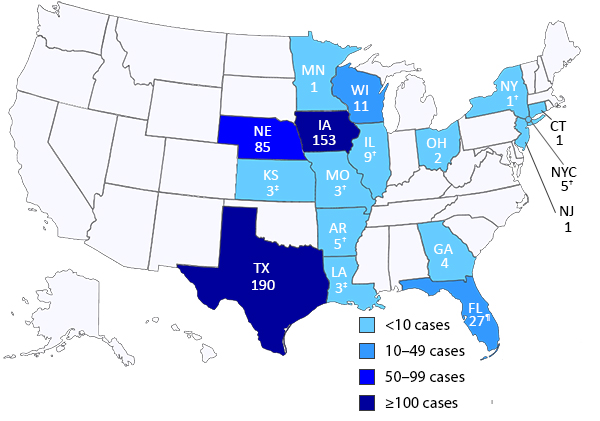H7N9 study finds limited aerosol transmission in ferrets
A study on aerosol transmission of the novel H7N9 virus in ferrets found evidence of limited spread at levels more robust than avian influenza viruses, but less than seasonal flu and the 2009 H1N1 virus, researchers reported yesterday.
The group, from Erasmus Medical Center in the Netherlands and the University of Cambridge in the United Kingdom, published its findings in Nature.
The researchers infected four ferrets with the Anhui/1/2013 H7N9 strain, and the following day a cage of four unexposed ferrets next to them. The configuration prevented direct contact but allowed airborne transmission.
The scientists found that the H7N9 virus was transmitted to three of the four ferrets. All three of them seroconverted 2 weeks after exposure. Genetic sequencing found that two of the airborne-transmitted viruses were identical.
Their experiments also suggested that residual binding to alpha-2-3–linked sialic acids and hemagglutinin instability appeared to limit transmission of the virus isolate that they tested. They concluded that further changes may be needed for the H7N9 virus to transmit more efficiently in mammals.
The group's findings are similar to other recent studies of H7N9 transmission in ferrets. For example, a team from China recently found that the Anhui strain of H7N9 was highly transmissible in ferrets.
Aug 7 Nature abstract
Jul 18 CIDRAP News story "Study: H7N9 highly transmissible by airborne route"
Study says H7N9 may have lurked in live-poultry markets
A phylogenetic analysis of the evolution of influenza A virus H7 and N9 subtypes in wild and domestic birds in East Asia found that the novel H7N9 virus that has caused more than 130 human cases in China this year probably emerged after long, silent circulation in live-poultry markets, according to a study today in Emerging Infectious Diseases.
US and Reunion researchers used Bayesian Markov Chain Monte Carlo coalescent analyses on 715 hemagglutinin (HA) and 309 neuraminidase (NA) sequences of viruses isolated from 1927 through 2012 worldwide.
Consistent with previous studies, they found that the HA of human H7N9 viruses belongs to clade A and is most genetically related to viruses isolated from domestic ducks at live-poultry markets in Zhejiang Province, China. They further determined that the HA did not evolve from the H7 HA circulating in these domestic birds but was derived from a common ancestral flu virus circulating in an "unidentified host" during 2010.
The researchers write that the most recent common ancestor was an H7N3 virus in a domestic duck and an H7 subtype circulating in wild birds from 2004. They say this indicates "that silent introduction and circulation of influenza A virus H7 subtypes in domestic animals might have occurred in this virus before influenza A(H7N9) virus was identified in humans."
They further write that H7N9 NA might have originated from influenza H11N9 viruses that circulated in eastern China, although data on the NA portion of the virus are limited.
"Although we cannot formally exclude that local transmission of influenza A virus from domestic to wild birds has occurred, lack of evidence for reintroduction of poultry-adapted viruses into wild birds suggests there has been little to no dissemination of influenza A(H7N9) virus by waterfowl along their migratory flyways," the authors state.
Aug 8 Emerg Infect Dis report
WHO releases MERS guide for home care givers
Although the World Health Organization (WHO) said in guidance today that care in a healthcare setting for Middle East respiratory syndrome coronavirus (MERS-CoV) cases "might be prudent," it listed specific steps for home care for patients with mild illness when it's necessary, including hand hygiene, respiratory hygiene, and distancing measures.
Among the 16 recommendations listed, the WHO said to limit contact with a confirmed or suspected case-patient as much as possible, especially for those at risk; wash hands frequently; perform respiratory hygiene such as covering coughs; avoid direct contact with solid waste and bodily fluids from the patient; and disinfect surfaces regularly.
The 8-page document also details the management of contacts of MERS patients, which it defines as anyone exposed to the patient or living in the same household. The agency continues to not recommend quarantine for asymptomatic contacts.
Aug 8 WHO guidance
MVA-BN smallpox vaccine approved for European market
The smallpox vaccine known by the trade name Imvamune in the United States has been approved by the European Commission for marketing in the European Union, where it is called Imvanex, the drug's manufacturer, Bavarian Nordic, announced yesterday.
The vaccine, Modified Vaccinia Ankara–Bavarian Nordic (MVA-BN), is designed for use in adults, including those with a weakened immune system. It was developed under contracts initiated in 1999 with the US government and has, since 2010, been supplied to the US Strategic National Stockpile for use in the event of a national emergency such as a bioterrorist attack.
Smallpox was eradicated worldwide in 1980, but it is considered a high-priority bioterrorism threat.
MVA-BN is a strain of vaccinia virus that does not replicate in the immunized individual, unlike traditional smallpox vaccine, which is made from a live, replicating strain. The latter is not recommended for immunocompromised people, such as those with HIV or atopic dermatitis, and their household contacts because of the possibility of serious side effects.
The Bavaria Nordic company considers the new approval as evidence of "a strong partnership with the US government" and says it "proves that public-private enterprises can work if there is a shared vision and willingness to invest in a sustained biodefense market."
Aug 7 Bavarian Nordic press release













